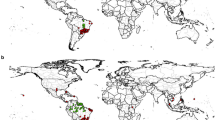Abstract
The silver carp and bighead carp (Cyprinidae), native to eastern Asia, have been introduced into the United States in attempts to improve water quality in aquaculture ponds, reservoirs, and sewage pools. Escaped or released specimens from fish farms have been reported in many states, and both species are already locally established and spreading further. We used the Genetic Algorithm for Rule-set Prediction (GARP) to model the niches of these two carps in their native ranges using hydrologic and general environmental parameters in concert with native distributional data. The results accurately predicted native occurrence data withheld from the modeling process (P < 0.01). We then projected the niche models onto the North American landscape. Native niche range models significantly predicted known occurrence data from North American introductions (P < 0.001). Further, the models suggest that both species have the potential of spreading throughout the eastern U.S. and selected areas of the West Coast.
Similar content being viewed by others
References
Anderson RP, Lew D, Peterson AT (2003) Evaluating predictive models of species’ distributions: criteria for selecting optimal models. Ecol Model 162:211–232
Boschung HT (1992) Catalogue of freshwater and marine fishes of Alabama. Bull Alabama Museum Nat Hist 14: 1–266
Chen Y, Chu X, Luo Y, Liu H, He M, Yue P (1998) Fauna sinica: Osteichthyes – Cypriniformes II. Science Press, Beijing China
Courtenay WR, Jr, Jennings DP, Williams JD (1991) Appendix 2. Exotic Fishes. In: Robins CR, Bailey RM, Bond CE, Brooker JR, Lachner EA, Lea RN, Scott WB (eds) Common and scientific names of fishes from the United States and Canada, American Fisheries Society Special Publication 20, Bethesda, Maryland, pp 97–107
Courtenay WR Jr, Stauffer JR Jr (1984) Distribution, biology, and management of exotic fishes. Johns Hopkins University Press, Baltimore Maryland
Dill WA, Cordone AJ (1997) History and status of introduced fishes in California. California Dept Fish Game Fish Bull 178:1871–1996
Feria TP, Peterson AT (2002) Using point occurrence data and inferential algorithms to predict local communities of birds. Divers Distributions 8:49–56
Fielding AH, Bell JF (1997) A review of methods for the assessment of prediction errors in conservation presence/absence models. Environ Conserv 24:38–49
Grinnell J (1917) Field tests of theories concerning distributional control. Am Nat 51:115–128
Hanley JA, McNeil BJ (1982) The meaning and use of the area under a Receiver Operating Characteristic (ROC) curve. Radiology 143:29–36
Iguchi K, Matsuura K, McNyset K, Peterson AT, Scachetti-Pereira R, Powers KA, Vieglais DA, Wiley EO, Yodo T (2004) Predicting Invasions of North American basses in Japan using native range data and a genetic algorithm. Trans Am Fish Soc 133:845–854
Jennings DP (1988) Bighead carp (Hypophthalmichthys nobilis): a biological synopsis. U.S. Fish Wildlife Serv 88:1–35
Kamilov BG, Salikhov TV (1996) Spawning and reproductive potential of the silver carp Hypophthalmichthys molitrix from the Syr Darya River. J Ichthyol 36:600–606
Kolar CS, Lodge DM (2002) Ecological predictions and risk assessment for alien fishes in North America. Science 298:1233–1236
Laird CA, Page LM (1996) Non-native fishes inhabiting the streams and lakes of Illinois. Illinois Nat Hist Survey Bull 35:1–51
Levine RS, Peterson AT, Benedict MQ (2004) Geographic and ecologic distributions of the Anopheles gambiae complex predicted using a genetic algorithm. Am J Trop Med Hyg 70:105–109
Mao J, Xu S (1991) The fauna of Zhejiang Province – freshwater fishes. Zhejiang Science and Technology Press, Hangzhou China
Nico L (2005) Hypophthalmichthys molitrix. Nonindigenous Aquatic Species Database, Gainesville, FL. Retrived from␣http://www.flgvwdmz014.er.usgs.gov/queries/FactSheet.asp?speciesID = 549 on 24 February 2005
Nico L, Fuller P (2005) Hypophthalmichthys nobilis. Nonindigenous Aquatic Species Database, Gainesville, FL. Retrived from http://www.flgvwdmz014.er.usgs.gov/queries/FactSheet.asp?speciesID = 551 on 24 February 2005
Peterson AT, Cohoon KC (1999) Sensitivity of distributional prediction algorithms to geographic data completeness. Ecol Model 117:159–164
Robison HW, Buchanan TM (1988) Fishes of Arkansas. The University of Arkansas Press, Fayetteville Arkansas
Shaanxi Aquaculture Institute and Biology Department of Shaanxi Normal University (1992) Fishes of Shaanxi Province. Shaanxi Science and Technology Press, Xi’an, China
Stockwell DRB (1999) Genetic algorithms II. In: Fielding AH (ed) Machine learning methods for ecological applications. Kluwer Academic Publishers, Boston, pp 123 −144
Stockwell DRB, Noble IR (1992) Induction of sets of rules from animal distribution data: a robust and informative method of analysis. Math Comp Simulat 33:385–390
Stockwell DRB, Peters DP (1999) The GARP modeling system: problems and solutions to automated spatial prediction. Int J Geogr Inf Sci 13:143–158
USGS (2004) Nonindigenous aquatic species. Biological Resource Division, U.S. Geological Survey (USGS). Retrieved from http://www.nas.er.usgs.gov/ on 18 December 2004
Wiley EO, McNyset KM, Peterson AT, Robins CR, Stewart AM (2003) Niche modeling and geographic range predictions in the marine environment using a machine-learning algorithm. Oceanography 16:120–127
Williams JD, Meffe GK (2000) Invasive nonindigenous species: a major threat to freshwater biodiversity. In: Abell RA (ed) Freshwater ecoregions of North America: a conservation assessment. Island Press, Washington D.C., pp 67–73
Zweig MH, Campbell G (1993) Reciver-Operating Characteristic (ROC) plots: a fundamental evaluation tool in clinical medicine. Clin Chem 39:561–577
Acknowledgments
The United States Geological Survey funded part of this study as part of their on-going assessment of invasive species. We thank Dr. C. Zhang, Beijing Institute of Zoology, Dr. J. Yang, Kunming Institute of Zoolgy, Drs. S. He and H. Liu, Wuhan Institute of Hydrobiology, for allowing access to their museum data; Drs. T.A. Peterson and D. Fautin, the University of Kansas, for constructive comments and helpful discussions. The Biodiversity Research Center, the University of Kansas, provided necessary informatics infrastruture, tools, and facilities that made this study possible.
Author information
Authors and Affiliations
Corresponding author
Rights and permissions
About this article
Cite this article
Chen, P., Wiley, E. & Mcnyset, K.M. Ecological niche modeling as a predictive tool: silver and bighead carps in North America. Biol Invasions 9, 43–51 (2007). https://doi.org/10.1007/s10530-006-9004-x
Received:
Accepted:
Published:
Issue Date:
DOI: https://doi.org/10.1007/s10530-006-9004-x




